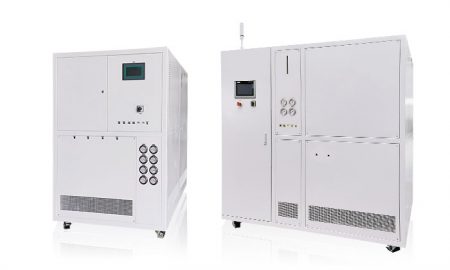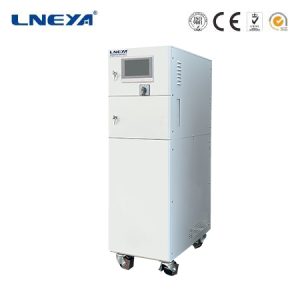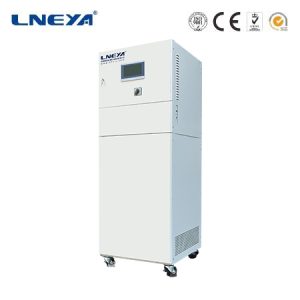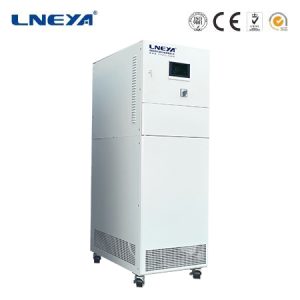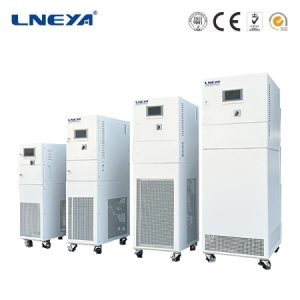Outdoor Water Cooled Chiller
Contattateci oggi stesso per la soluzione di controllo della temperatura perfetta
What is an outdoor water cooled chiller?
An outdoor water cooled chiller is one of those water chillers that removes heat from the water used in projects and industrial structures and puts the water back into the running cycle. In effect, a chiller moves heat from a space that requires temperature control to another space. Therefore, the chiller is not a means of generating cold, but a means of dissipating heat, whose task is to facilitate the transfer of unwanted and undesired heat caused by activity to places outside the system.
Cooling towers are specially designed for outdoor water cooled chillers. Because the condenser of a water-cooled chiller uses water as a stimulus and cooling material. The efficiency of a water-cooled chiller increases because wet surfaces are more successful at transferring heat and can do compression work at wetter temperatures.
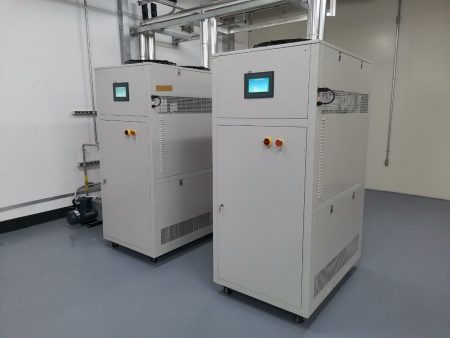
How does outdoor water cooled chiller work?
Water-cooled chillers come into play during the evaporation process, the water and gas produced by the machine are taken to the evaporator and collect all the unwanted heat on the way and then return to the evaporator and store the obtained heat energy. After that, the refrigerant collects this heat and mobilizes it into the condensate, that is, the condenser sends all the collected heat to the cooling tower, and finally the hot air will pass through the cooling coil and dissipate the heat to the atmosphere.
The first stage:
The starting point of this cycle is where the water from the production process enters the evaporator and enters the cooling cycle.
During this part of the cycle, the heat absorbed by the refrigerant first appears in the form of a phase change from liquid to gas phase. As the refrigerant absorbs heat from the water, the temperature of the environment in contact with this part drops, so the water leaves at a lower temperature. This water enters the fan coil and carries the cool air to the desired space.
In fact, the evaporator is a place that, in addition to the current cycle, participates in another cycle, which is located between the evaporator and the water outlet of the cooling device. In fact, hot water enters the chiller evaporator, which cools it and then pumps it throughout the building to where it is needed.
second stage:
The gaseous refrigerant reaches the gas phase in the pre-liquid state and then enters the compressor. In the compressor, the gas condenses and the temperature and pressure increase so that it can enter the next high-pressure stage. The rise in pressure and temperature as it leaves the compressor is important because the refrigerant needs to release heat from inside the condenser, so it must carry enough heat to the condenser.
Another key function of the compressor is to draw refrigerant into the evaporator at the right time, keeping the pressure within the evaporator high enough to absorb the heat again.
The third phase:
The high-temperature gas enters the condenser, where the gaseous refrigerant is converted into a saturated, high-pressure liquid. This is a constant pressure process.
Since the condenser exists in another loop between the cooling towers, the water enters the cooling tower after the temperature rises. Because the main task of the cooling tower in a water-cooled chiller is to cool the consumed water, and the condenser uses this water as its driving material.
Where the excess heat of the water disappears and the water temperature returns to the desired low temperature. The heating process we mentioned earlier occurs in the condenser, releasing the gaseous refrigerant from the heat itself, which is the source of heat in question and needs to be eliminated by the cooling tower. In this way, the water entering the cooling tower from the condenser comes into contact with the air flow, transfers heat to the air, and then returns to the condenser.
The fourth stage:
The expansion valve is the last stage of the refrigerant and the refrigerant in the expansion valve undergoes these processes causing the refrigerant to become a mixture of liquid and gas and the same compounds re-enter the evaporator to resume the cycle.
E-mail: info@lneya.com ID WeChat: +8615251628237 WhatsApp: +86 17851209193
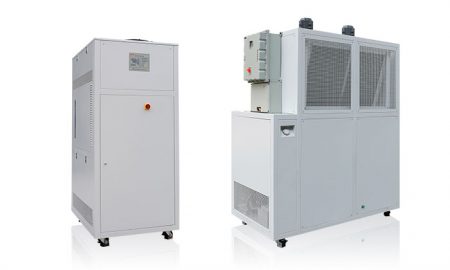 Refrigeratori di precisione / Piccoli refrigeratori
Refrigeratori di precisione / Piccoli refrigeratori
Il refrigeratore può essere ampiamente utilizzato in vari settori industriali e laboratori e supporta la progettazione personalizzata.
| Intervallo di temperatura | -18°C ~ +30°C | Serie +5°C ~ +35°C | |||||||
| Capacità di raffreddamento | 0,35 ~ 0,9 kW | 1,8 ~ 50kW | |||||||
| Nota: qualsiasi intervallo di temperatura da -150℃ a +350℃ e qualsiasi capacità di raffreddamento possono essere personalizzati. | |||||||||
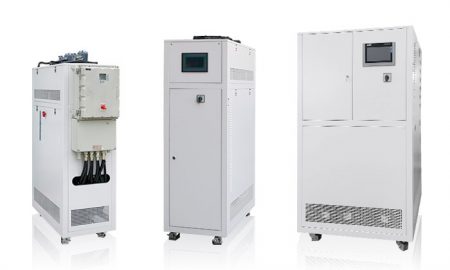
Refrigeratori a ricircolo
Il nostro refrigeratore a ricircolo adotta la tecnologia di refrigerazione a bassa temperatura, la temperatura è fino a -120℃ e vari accessori sono personalizzabili.
| Intervallo di temperatura | Serie -25°C ~ +30°C | Serie -45°C ~ +30°C | Serie -60°C ~ -20°C | Serie -80°C ~ -20°C | Serie -120°C ~ -70°C | ||||
| Capacità di raffreddamento | 0,8 ~ 30kW | 0,75 ~ 12kW | 0,4 ~ 6kW | 0,2 ~ 6kW | 0,3 ~ 5kW | ||||
| Nota: qualsiasi intervallo di temperatura da -150℃ a +350℃ e qualsiasi capacità di raffreddamento possono essere personalizzati. | |||||||||
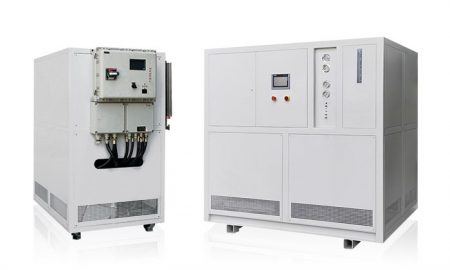
Refrigeratori a bassa temperatura
Siamo specializzati nella produzione di refrigeratori a bassa temperatura con un range di controllo della temperatura fino a -150°C, in grado di soddisfare le esigenze di refrigerazione di diversi settori industriali.
| Intervallo di temperatura | Serie -25°C ~ -5°C | Serie -45°C ~ -10°C | Serie -60°C ~ -10°C | Serie -80°C ~ -30°C | Serie -110°C ~ -50°C | Serie -150°C ~ -110°C | |||
| Capacità di raffreddamento | 12 ~ 360kW | 6 ~ 180kW | 6 ~ 180kW | 4 ~ 180kW | 2 ~ 120kW | 2,5 ~ 11kW | |||
| Nota: qualsiasi intervallo di temperatura da -150℃ a +350℃ e qualsiasi capacità di raffreddamento possono essere personalizzati. | |||||||||
Simulazione della temperatura per il test di qualità del veicolo: test di durata della batteria, banco di prova dell'iniettore/motore del carburante, test dell'airbag, banco di prova dei componenti, ecc.
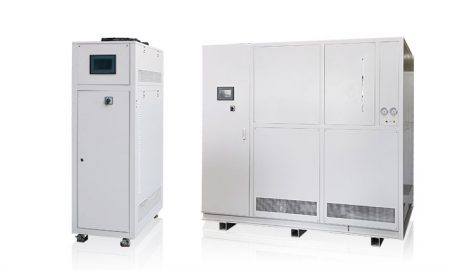
Adatto per il controllo preciso della temperatura dei componenti elettronici. Nella produzione di componenti elettronici a semiconduttore per ambienti difficili, le fasi di assemblaggio dell'imballaggio IC e di test di progettazione e produzione includono test termici elettronici e altre simulazioni di test ambientali.

Raffreddamento a liquido per i sistemi di accumulo di energia a batteria
| Tipi | Per la stazione di conversione | Per la batteria di accumulo dell'energia | Per la stazione di ricarica | ||||||
| Capacità di raffreddamento | 45kW | 5 ~ 8,5kW | 4kW | ||||||
| Nota: qualsiasi intervallo di temperatura da -150℃ a +350℃ e qualsiasi capacità di raffreddamento possono essere personalizzati. | |||||||||

Serie ZLFQ
Unità di distribuzione del refrigerante
L'apparecchiatura di raffreddamento a liquido è adatta per il test dei semiconduttori, per il test della temperatura costante delle apparecchiature elettroniche, per il raffreddamento dell'infrastruttura di supporto dei server e per altri luoghi di controllo della temperatura dei fluidi.
| Intervallo di temperatura | +5°C ~ +35°C | +5°C ~ +35°C | |||||||
| Capacità di raffreddamento | 15 ~ 150kW | 200 ~ 500kW | |||||||
| Nota: qualsiasi intervallo di temperatura da -150℃ a +350℃ e qualsiasi capacità di raffreddamento possono essere personalizzati. | |||||||||

Serie di mandrini termici MD
Viene utilizzato per testare dispositivi RF e dispositivi di potenza ad alta densità (IGBT e MOSFET) e può essere utilizzato anche per il raffreddamento rapido di pannelli piatti da laboratorio (plasma, prodotti biologici, batterie), ecc.
| Intervallo di temperatura | -75°C ~ +225°C | ||||||||
| Precisione della temperatura | ±0.1℃ | ||||||||
| Nota: qualsiasi intervallo di temperatura da -150℃ a +350℃ e qualsiasi capacità di raffreddamento possono essere personalizzati. | |||||||||
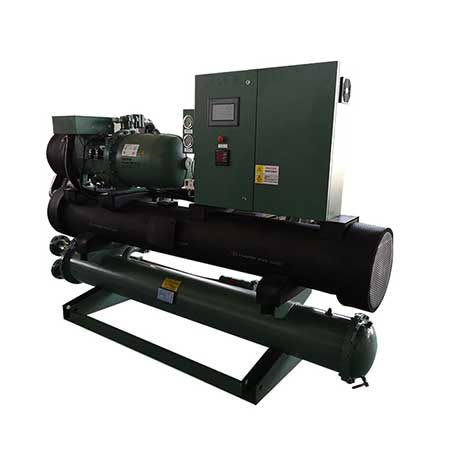
Refrigeratori a vite (Disegni personalizzati)
Refrigeratori a vite a bassa temperatura e a temperatura ambiente
| Intervallo di temperatura | +5°C ~ +30°C | +5°C ~ +30°C | +5°C ~ +30°C | +5°C ~ +30°C | -25°C ~ +5°C | -25°C ~ +5°C | |||
| Capacità di raffreddamento | 107 ~ 1027kW (compressore singolo) | 299 ~ 2134kW (doppio compressore) | 98 ~ 934kW (compressore singolo) | 272 ~ 1940kW (doppio compressore) | 48 ~ 467kW (compressore singolo) | 51 ~ 497kW (compressore singolo) | |||
| Nota: qualsiasi intervallo di temperatura da -150℃ a +350℃ e qualsiasi capacità di raffreddamento possono essere personalizzati. | |||||||||
 LNEYA
LNEYA
 简体中文
简体中文












































































